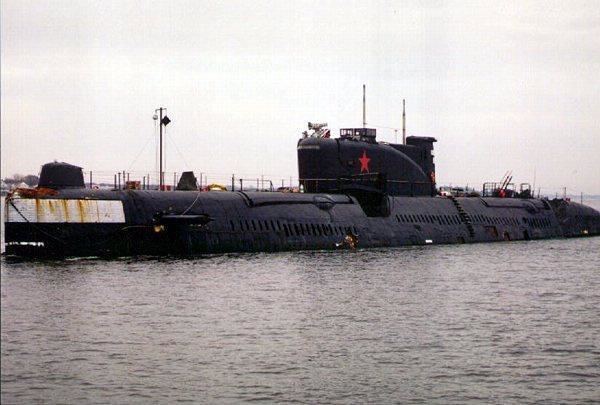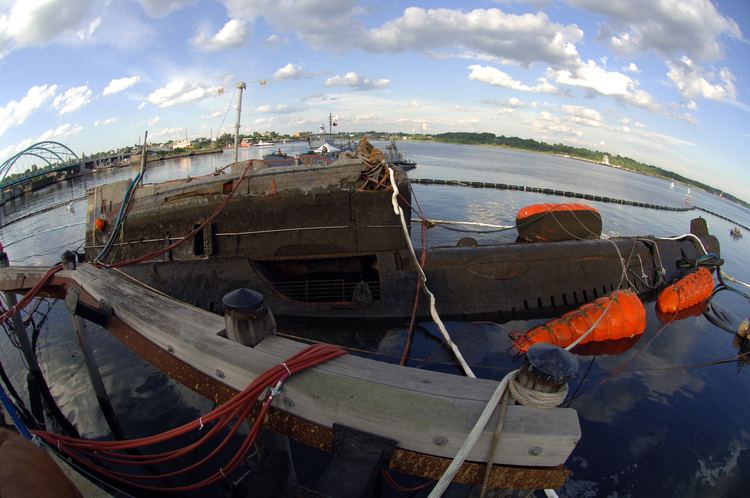Name K-77 Laid down 31 January 1963 Struck 1994 Launched 11 March 1965 Commissioned 31 October 1965 | Ordered 1950s Decommissioned 1991–1994 Construction started 31 January 1963 Length 91 m | |
 | ||
Fate Restaurant, beauty pageant, film set, museum shipSank in 2007,Recovered and refloated in 2008,Sold for scrap August 2009 Similar Uss Saratoga Museum, Submarine Juliett U‑461 ‑ G, Submarine Force Library a, Soviet submarine B‑39, USS Torsk | ||
K-77 was a "Project 651" (also known by its NATO reporting name of Juliett-class) cruise missile submarine of the Soviet Navy. Her keel was laid down in the Krasnoye Sormovo shipyard in Gorky on 31 January 1963. She was launched on 11 March 1965, and commissioned on 31 October 1965 into the Northern Fleet.
Contents

K-77 was built later in the Juliett class, so her hull was conventional steel and her battery was of the conventional lead-acid type, rather than the austenitic steel and silver-zinc batteries used in the first Julietts. K-77 was also used as the set for the motion picture K-19: The Widowmaker, starring Harrison Ford and Liam Neeson.

Career

The details of K-77’s career remain largely unknown. Juliett-class submarines were used to follow United States Navy aircraft carrier battle groups in the North Atlantic Ocean and the Mediterranean Sea. Circumstantial evidence indicates that K-77 often patrolled the Mediterranean, off the coast of West Africa, and at least once in the Caribbean Sea near the United States Virgin Islands. Papers found aboard her during inspection in Helsinki suggest that she had shadowed Norwegian Kobben-class submarines.

At some point in her career, K-77 (the K standing for крейсерская, kreyserskaya — "cruiser") was redesignated Б-77 (the Б standing for большая, bolshaya — "large"). In 1987, K-77 was withdrawn from the blue-water Northern Fleet and transferred to the Baltic Fleet. The redesignation and transfer could easily be related.

The Soviet Navy began withdrawing the Julietts from active service in 1988. K-77 was decommissioned sometime after 1991, and by the end of 1994, all Julietts had been retired.
Finland

At the end of the Cold War, Finnish businessman Jari Komulainen, who was married to the only daughter of President of Finland Mauno Koivisto, used his influence as Finland's "first son-in-law" to convince the Russian government to lease him a Project 641 "Foxtrot" class submarine, probably the ex-B-39. Komulainen opened it to the public in Helsinki in the spring of 1993 as a tourist attraction. He then purchased two Juliett-class submarines, one Juliett replacing the Foxtrot in 1994, becoming a bar and restaurant as well as a tourist attraction. Komulainen believed that his restaurant had been K-81, based on a metal plate discovered inside the boat. However, it later transpired that that plate and others bearing different numbers were provided for the crew to display on the submarine's sail during surface running to confuse NATO reconnaissance aircraft. Komulainen also held a beauty pageant “Miss Submarine” at his Soviet submarine K-77. Model Anitra Ahtola won the competition who became later his third wife.

As a restaurant, K-77 was modestly successful, but was not lucrative enough to satisfy Komulainen. In 1998, he leased his submarine to a Canadian promoter, who towed it to Tampa Bay, Florida. However, the intended mooring location in the harbor was too shallow and the investors were forced to move the proposed tourist attraction to a more remote site. Soon, the promoter filed for bankruptcy, and K-77 reverted to Komulainen.
eBay

Komulainen did not want to repeat the nerve-wracking trans-Atlantic tow, and instead tried at least twice to auction the submarine on eBay — auctions #222791130, ending on 20 December 1999, and #270148521, ending on 7 March 2000. In each case, bidding was to start at US$1 million. No bids were received.
Widowmaker
The eBay auction, however, caught the attention of Intermedia Film Equities Ltd., who chartered K-77 for US$200,000 and towed her to Halifax, Nova Scotia, in 2000 to become the set for the motion picture K-19: The Widowmaker, starring Harrison Ford and Liam Neeson. The boat was modified with fiberglass to make it resemble the K-19 submarine.
Museum
The film wrapped up in 2002, when the submarine was purchased by the USS Saratoga Museum Foundation,[2] towed to Collier Point Park in Providence, Rhode Island, and opened to the public in August 2002. The K-77 offered public tours and a comprehensive educational program in accordance with New Standards and attuned to the advancement requirements of both Boy Scout and Girl Scout programs.
When the Saratoga Museum Foundation took possession of the submarine, it was described as K-81 in the initial press releases from the Saratoga Museum Foundation. The Foundation spent months refurbishing the interior, which included removing several bulkheads, moving large pieces of equipment, and going deep into the bilges. During this process, documents were found which provided incontrovertible proof that the submarine was the K-77 and not the K-81 as earlier thought. The records confirming this information include maintenance reports, equipment exchanges, radio messages, duty rosters, log entries, and torpedo firing exercises, which all identify the submarine as K-77.
Sinking
The submarine sank on April 18, 2007 after a storm, and plans were made to raise it off the river bottom. The Museum's theory on why the submarine sank is that a modified hatch was not properly watertight. Recovery efforts by U.S. Navy and Army divers began in June 2008 as part of a project to train military divers through real-world, community-based projects.
On June 2, 2008, divers from Mobile Diving and Salvage Unit Two in Norfolk, Virginia arrived and began preparations to raise the submarine. On July 25, 2008, she was brought to the surface by US Navy and Army divers. The work of pumping out water was completed in August 2008. The sub was badly deteriorated and in need of substantial repair.
On August 11, 2009, RI Recycled Metals LLC towed the sub to a facility 1000 yards from the museum site so that it could be scrapped.
A portion of the vessel remained in the river and in 2017, a judge ordered that the remnants be removed.
